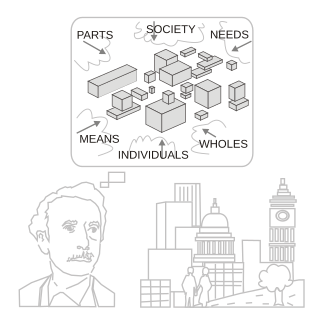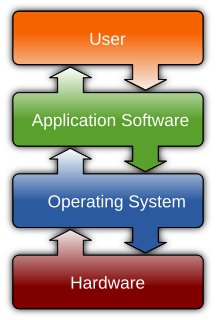
Computing is any activity that uses computers. It includes developing hardware and software, and using computers to manage and process information, communicate and entertain. Computing is a critically important, integral component of modern industrial technology. Major computing disciplines include computer engineering, software engineering, computer science, information systems, and information technology.
The Merriam-Webster dictionary defines system analysis as "the process of studying a procedure or business in order to identify its goals and purposes and create systems and procedures that will achieve them in an efficient way". Another view sees system analysis as a problem-solving technique that breaks down a system into its component pieces for the purpose of the studying how well those component parts work and interact to accomplish their purpose.
Information systems (IS) are formal, sociotechnical, organizational systems designed to collect, process, store, and distribute information. In a sociotechnical perspective, information systems are composed by four components: task, people, structure, and technology.
Rapid-application development (RAD), also called Rapid-application building (RAB), is both a general term, used to refer to adaptive software development approaches, as well as the name for James Martin's approach to rapid development. In general, RAD approaches to software development put less emphasis on planning and more emphasis on an adaptive process. Prototypes are often used in addition to or sometimes even in place of design specifications.
Software development is the process of conceiving, specifying, designing, programming, documenting, testing, and bug fixing involved in creating and maintaining applications, frameworks, or other software components. Software development is a process of writing and maintaining the source code, but in a broader sense, it includes all that is involved between the conception of the desired software through to the final manifestation of the software, sometimes in a planned and structured process. Therefore, software development may include research, new development, prototyping, modification, reuse, re-engineering, maintenance, or any other activities that result in software products.
The Higher School Certificate (HSC) is the credential awarded to secondary school students who successfully complete senior high school level studies in New South Wales, Australia. It was first introduced in 1967, with the last major revision coming into effect in 2001. It is currently developed and managed by the NSW Education Standards Authority (NESA).

The systems development life cycle (SDLC), also referred to as the application development life-cycle, is a term used in systems engineering, information systems and software engineering to describe a process for planning, creating, testing, and deploying an information system. The systems development lifecycle concept applies to a range of hardware and software configurations, as a system can be composed of hardware only, software only, or a combination of both. There are usually six stages in this cycle: analysis, design, development and testing, implementation, documentation, and evaluation.

Systems science is an interdisciplinary field that studies the nature of systems—from simple to complex—in nature, society, cognition, engineering, technology and science itself. To systems scientists, the world can be understood as a system of systems. The field aims to develop interdisciplinary foundations that are applicable in a variety of areas, such as psychology, biology, medicine, communication, business management, engineering, and social sciences.

The Open Group Architecture Framework (TOGAF) is a framework for enterprise architecture that provides an approach for designing, planning, implementing, and governing an enterprise information technology architecture. TOGAF is a high level approach to design. It is typically modeled at four levels: Business, Application, Data, and Technology. It relies heavily on modularization, standardization, and already existing, proven technologies and products.
Industrial arts is an educational program which features fabrication of objects in wood or metal using a variety of hand, power, or machine tools. It may include small engine repair and automobile maintenance, and all programs usually cover technical drawing as part of the curricula. As an educational term, industrial arts dates from 1904 when Charles R. Richards of Teachers College, Columbia University, New York suggested it to replace manual training.
Business analysis is a research discipline of identifying business needs and determining solutions to business problems. Solutions often include a software-systems development component, but may also consist of process improvement, organizational change or strategic planning and policy development. The person who carries out this task is called a business analyst or BA.

The systems architect is a professional figure in information and communications technology. Systems architects define the architecture of a computerized system in order to fulfill certain requirements. Such definitions include: a breakdown of the system into components, the component interactions and interfaces, and the technologies and resources to be used in the design.
The Bachelor of Computer Science or Bachelor of Science in Computer Science is a type of bachelor's degree, usually awarded after three or four years of collegiate study in computer science, but possibly awarded in fewer years depending on factors such as an institution's course requirements and academic calendar. In some cases it can be awarded in five years. In general, computer science degree programs emphasize the mathematical and theoretical foundations of computing.

St George Christian School is an independent Christian day school located in Hurstville and Sans Souci, both suburbs of southern Sydney, in the St George area of New South Wales, Australia.
The engineering design process is a methodical series of steps that engineers use in creating functional products and processes. The process is highly iterative - parts of the process often need to be repeated many times before another can be entered - though the part(s) that get iterated and the number of such cycles in any given project may vary.
…It is a decision making process in which the basic sciences, mathematics, and engineering sciences are applied to convert resources optimally to meet a stated objective. Among the fundamental elements of the design process are the establishment of objectives and criteria, synthesis, analysis, construction, testing and evaluation.
Informatics is a branch of information engineering. It involves the practice of information processing and the engineering of information systems, and as an academic field it is an applied form of information science. The field considers the interaction between humans and information alongside the construction of interfaces, organisations, technologies and systems. As such, the field of informatics has great breadth and encompasses many subspecialties, including disciplines of computer science, information systems, information technology and statistics. Since the advent of computers, individuals and organizations increasingly process information digitally. This has led to the study of informatics with computational, mathematical, biological, cognitive and social aspects, including study of the social impact of information technologies.
The Higher School Certificate (HSC) Economics course is a 2-unit elective course undertaken by students in New South Wales across their final 2 years of schooling. The course includes a preliminary program for study across 3 terms of Year 11, and an HSC course for study over 4 terms of Year 12. In 2012, 5,262 students sat the HSC Economics external examination, with 12.5% receiving the top performance indicator of a Band 6. The course aims to take a "problems and issues approach" to the teaching and learning of economics, with a particular emphasis on the economic problems and issues experienced by individuals and society.
ITIL, an acronym for Information Technology Infrastructure Library, is a set of detailed practices for IT service management (ITSM) that focuses on aligning IT services with the needs of business.











